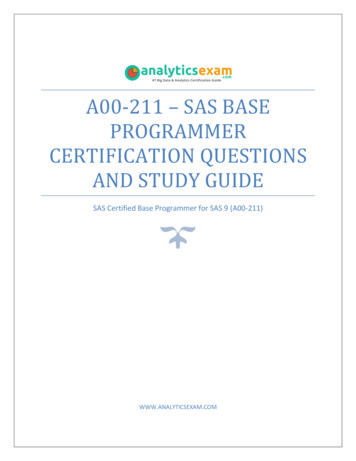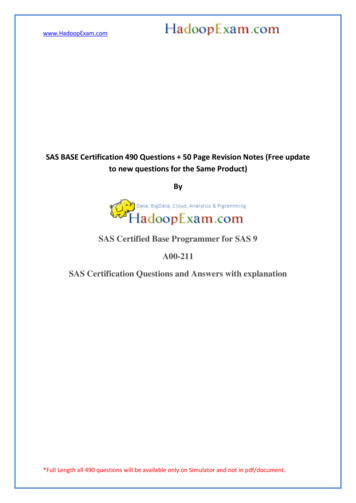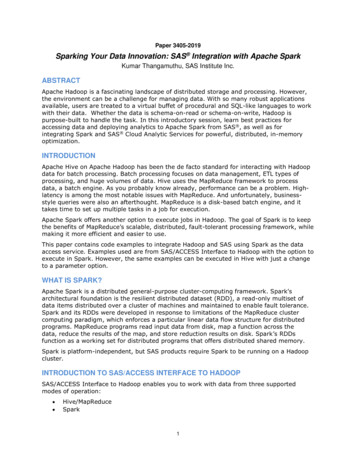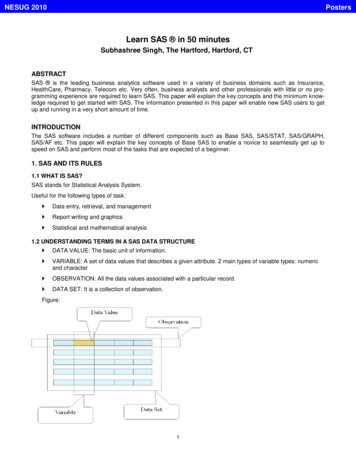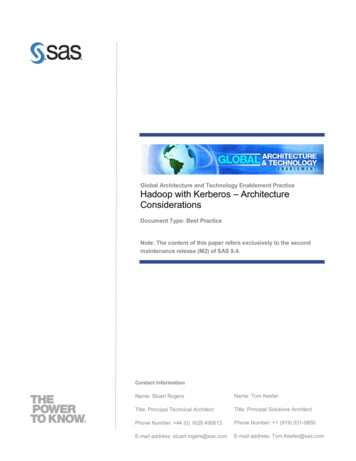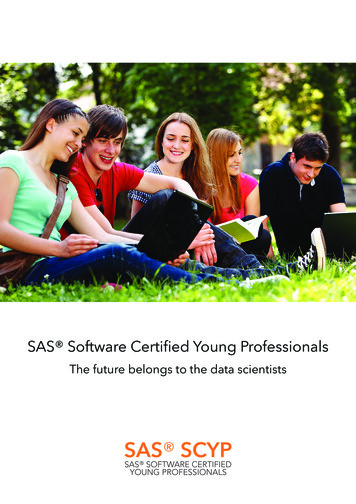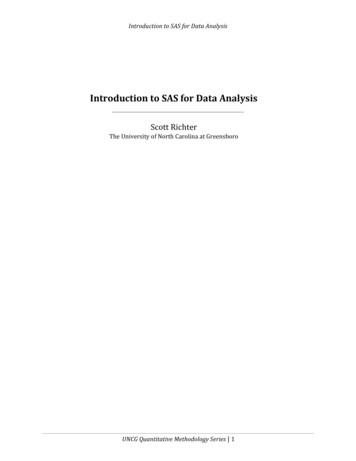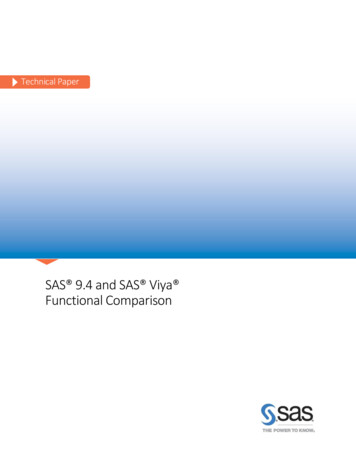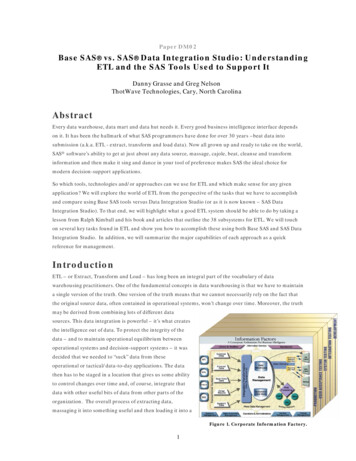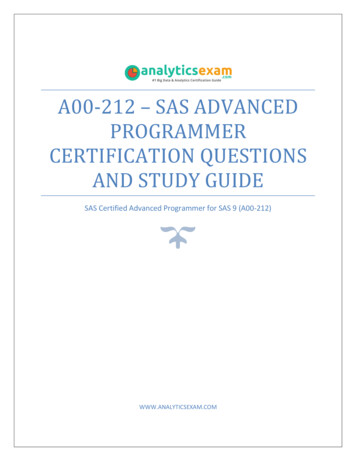
Transcription
A00-212 – SAS ADVANCEDPROGRAMMERCERTIFICATION QUESTIONSAND STUDY GUIDESAS Certified Advanced Programmer for SAS 9 (A00-212)WWW.ANALYTICSEXAM.COM
A00-212 –SAS ADVANCED PROGRAMMER CERTIFICATION QUESTIONS AND STUDY GUIDEContentsSAS Advanced Programmer Details . 2SAS Advanced Programmer Syllabus for A00-212 Exam (Study Aid) . 3SAS Advanced Programmer (A00-212) Sample Questions. 4www.analyticsexam.comPage 1
A00-212 –SAS ADVANCED PROGRAMMER CERTIFICATION QUESTIONS AND STUDY GUIDESAS Advanced Programmer CertificationDetailsExam NameExam CodeDurationPassing PercentageNegative MarkingPartial CreditSAS Certified Advanced Programmer for SAS 9A00-212120 Minutes65%No Negative MarkingNoReference BookSAS Certification Prep Guide: Advanced Programming for SAS 9, FourthEditionPearson VUESchedule Your examSample QuestionsRecommended Practicetoolwww.analyticsexam.comSAS Advanced Programmer Certification Sample QuestionSAS Advanced Programmer Certification Practice ExamPage 2
A00-212 –SAS ADVANCED PROGRAMMER CERTIFICATION QUESTIONS AND STUDY GUIDESAS Advanced Programmer CertificationSyllabus for A00-212 (Study Aid)Accessing Data Using SQL Generate detail reports by working with a single table, joining tables, or using setoperators in the SQL procedure.Generate summary reports by working with a single table, joining tables, or using setoperators in the SQL procedure.Construct sub-queries and in-line views within an SQL procedure step.Compare solving a problem using the SQL procedure versus using traditional SASprogramming techniques.Access Dictionary Tables using the SQL procedure. Macro ProcessingCreate and use user-defined and automatic macro variables within the SAS MacroLanguage.Automate programs by defining and calling macros using the SAS Macro Language.Understand the use of macro functions.Use various system options that are available for macro debugging and displaying valuesof user-defined and automatic macro variables in the SAS log.Create data-driven programs using SAS Macro Language.Advanced Programming Techniques Demonstrate the use of advanced data look-up techniques such as array processing,hash objects, formats, and combining/merging data.Reduce computing resource requirements by controlling the space required to store SASdata sets using compression techniques, length statements, or eliminating variables andobservations.Reduce programming time by developing reusable SAS programs which incorporate datastep views, DATA steps that write SAS programs, and the FCMP procedure.Perform effective benchmarking by using the appropriate SAS System options andinterpreting the resulting resource utilization statistics.Identify appropriate applications for using indexes and create them using the DATAstep, the DATASETS procedure, or the SQL procedure.Compare techniques to eliminate duplicate data using the DATA step, the SORT procedure, andthe SQL procedure.www.analyticsexam.comPage 3
A00-212 –SAS ADVANCED PROGRAMMER CERTIFICATION QUESTIONS AND STUDY GUIDESAS Advanced Programmer Exam (A00-212)Sample Questions Below are the 10 sample questions which will help you be familiar with SAS CertifiedAdvanced Programmer for SAS 9 (A00-212) exam style and Structure. These questions are just for demonstration purpose, there are many scenario basedquestion are included in Premium SAS Advanced Programmer Practice Exam Access to all 335 questions is available only through premium practice exam availableto members at www.analyticsexam .comQUESTION 1: The following SAS program is submitted:reuse YES;data sasuser RealEstate(compress CHAR);set sasuser houses;run;What is the effect of the REUSE YES SAS system option?A.B.C.D.ItItItIttracksallowsallowsallowsand recycles free spacea permanently stored SAS data set to be replacedusers to access the same SAS data set concurrentlyupdates in placeQUESTION 2: The following SAS program is submitted:%let dept prod;%let prod merchandise;The following message is written to the SAS log:The value is "merchandise"Which SAS System option writes this message to the SAS uote(&&&dept);QUESTION 3: Which one of the following techniques concatenates data in SAS?A.B.C.D.thethethetheAPPEND procedureDATA step with a MERGE statementDATA step with a COMBINE statementINTERSECT operator in the SQL procedurewww.analyticsexam.comPage 4
A00-212 –SAS ADVANCED PROGRAMMER CERTIFICATION QUESTIONS AND STUDY GUIDEQUESTION 4: Which one of the following is the purpose of the IDXNAME dataset instructsSASSASSASSAStotototoname and store a specific index.store an index in a particular location.use a specific index for WHERE processing.use any available index for WHERE processing.QUESTION 5: The following SAS program is submitted:Data sasuser.history;Set sasuser.history(keep state x yRename (state ST));Total sum(x,y);Run;The SAS data set SASUSER.HISTORY has an index on the variable STATE.Which describes the result of submitting the SAS onononSTATESTATESTATESTATEisisisisdeleted and an index on ST is createdrecreated as an index on STdeletedupdated as an index on STQUESTION 6: Which SAS procedure changes the name of a permanent formatfor a variable stored in a SAS ON 7: The following SAS program is submitted:%macro one(input);%two;%put the value is &date;%mend;%macro two;data null ;call symput('date','12SEP2008');run;%mend;%let date 31DEC2006;%one(&date)What is the result when the %PUT statement executes?www.analyticsexam.comPage 5
A00-212 –SAS ADVANCED PROGRAMMER CERTIFICATION QUESTIONS AND STUDY GUIDEA. A macro variable DATE with the valuesymbol table for the ONE macroB. A macro variable DATE with the valuesymbol table for the TWO macroC. A macro variable DATE with the valuesymbol tableD. A macro variable DATE with the valuesymbol table12SEP2008 is retrieved from the local12SEP2008 is retrieved from the local12SEP2008 is retrieved from the global31DEC2006 is retrieved from the globalQUESTION 8: Which SET statements option names a variable that contains thenumber of the observation to read during the current iteration of the DATAstep?A.B.C.D.OBS pointobsPOINT pointobsKEY pointobsNOBS pointobsQUESTION 9: Which one of the following is true regarding the KEEPstatement?A.B.C.D.The KEEP statement is available in both the DATA and the PROC steps.The KEEP statement selects the variables read from the input data set(s).The KEEP statement applies to all data sets created within the same DATA step.The KEEP statement applies only to the first data set created within the sameDATA step if more than one data set is created.QUESTION 10: When reading a SAS data file, what does the NOBS option onthe SET statement represent?A. A variableset(s)B. A variableset(s)C. A variableD. A variablethat represents the total number of observations in the input datathat represents the total number of observation in the output datathat represents a flag indicating the end of the filethat represents the current observation numberAnswers:Question: 1Question: 3Question: 5Question: 7Question: 9Answer: AAnswer: AAnswer: CAnswer: CAnswer: Cwww.analyticsexam.comQuestion: 2Question: 4Question: 6Question: 8Question: 10Answer: AAnswer: CAnswer: AAnswer: BAnswer: APage 6
A00-212 –SAS ADVANCED PROGRAMMER CERTIFICATION QUESTIONS AND STUDY GUIDE www.analyticsexam.com Page 2 SAS Advanced Programmer Certification Details Exam Name SAS Certified Advanced Programmer for SAS 9 Exam Code A00-212 Duration 120 Minutes Passing Percentage 6
